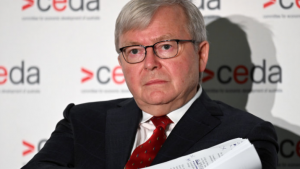Home » Commentary » Opinion » There’s no call for pink batts version 2020
· Financial Review
 The remarkable thing about the December quarter national accounts is that despite all the focus on particular areas of weakness in the economy during 2019, it managed to end up with growth of 0.5 per cent or 0.6 per cent each quarter for an annual total of 2.2 per cent.
The remarkable thing about the December quarter national accounts is that despite all the focus on particular areas of weakness in the economy during 2019, it managed to end up with growth of 0.5 per cent or 0.6 per cent each quarter for an annual total of 2.2 per cent.
Perhaps there is a lesson in this: don’t become too fixated on what is happening in particular sectors at any point in time, because there are always surprises somewhere else.
The national accounts do point to concerns about economic performance — just not so much the overall growth rate.
The result was too dependent on rapid growth in government consumption expenditure; business investment was very weak throughout the year; and productivity growth was low to non-existent.
The weakness in business investment and productivity are threats to the future sustainability of growth in the economy, real wages and living standards.
But — taking a short-term view — while 2.2 per cent annual growth (and 0.7 per cent in per capita terms) is nothing to crow about, it’s far from recession territory, and the economy entered 2020 with some momentum.
That is all in the rear view mirror. We now know that the bushfires and coronavirus (or COVID-19) impacts will detract from that momentum, though the extent and duration are highly speculative at this stage.
The question for policymakers is, what can and should macro policy do to offset those negative impacts?
In the spirit of ‘don’t just stand there, so something’, the Reserve Bank has acted swiftlywith its 25 basis points cash rate cut. This will do no harm in the short-term — but also little good.
The authorities need to keep the financial plumbing in order in times such as these, but that doesn’t have to mean cutting interest rates.
A cut in rates will do very little to relieve fear and uncertainty about COVID-19 or the supply chain problems it has created.
Rates were already so low that they were not a hindrance to anyone wanting to spend or invest; and the cut may inflate asset prices (particularly house prices) further.
The main effect will be to transfer income from bank depositors and shareholders to borrowers, who will put most of any extra spare money into precautionary saving.
Meanwhile, whenever the coronavirus scare subsides, the RBA will be slow to reverse course or will not do so at all, and the economy will be dealing with the damage wrought by interest rates even closer to zero than they already were.
Taking a global view, the US Federal Reserve is highly influential, and it is easy to imagine a scenario in which the Fed finds it has overdone the policy easing but can’t easily reverse course because it has to run the gauntlet of market tantrums and Trump’s tweets — and in an election year to boot.
Turning to fiscal policy, any significant weakening in economic activity and commodity prices is likely to deprive the Morrison government of its budget surplus — this year or next — purely from the automatic effects on tax revenue and social welfare payments.
While this would be politically uncomfortable for the government, it is desirable from an economic viewpoint and should not be resisted. This is the working of automatic fiscal stabilisers.
The bigger issue is whether the government should inject a discretionary fiscal stimulus; for example, something of the kind (but not the magnitude) of the Rudd government’s fiscal response to the global financial crisis.
The answer, at least at this stage, should be a resounding ‘no’. The scale of COVID-19 and its economic implications are far too speculative.
On top of that, there are too many doubts about the effectiveness of fiscal stimulus, and the lags are too long, for it to be a suitable response. It would also risk derailing the much-needed structural fiscal repair that was under way.
That does not rule out implementing permanent, structural fiscal reforms that might also help support the economy in the short term, even if this means postponing the return to budget balance or surplus.
On the tax side, such structural changes could include an investment allowance (in the absence of a superior company tax cut) and bringing forward some or all of the personal income tax cuts slated for 2022 and 2024.
Above all, policymakers should not act simply to be seen to be doing something. With that motive, the story always ends badly.
There’s no call for pink batts version 2020